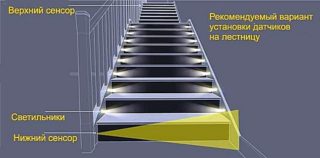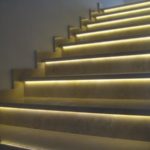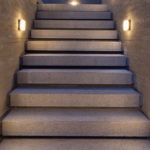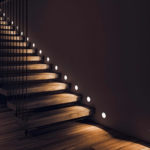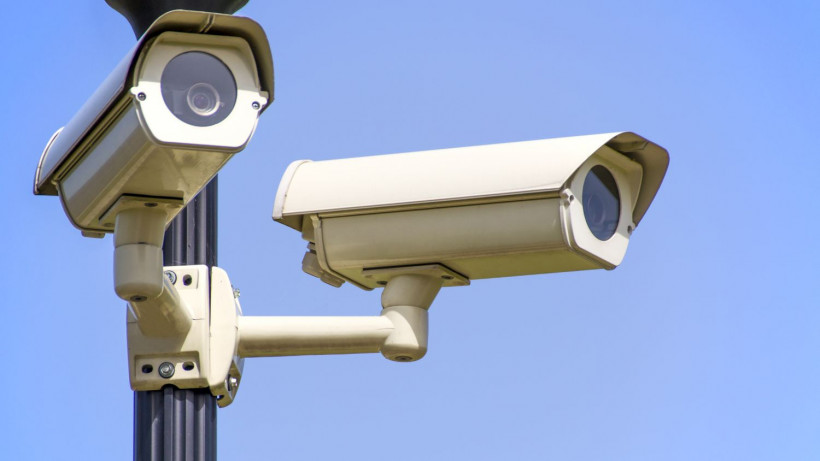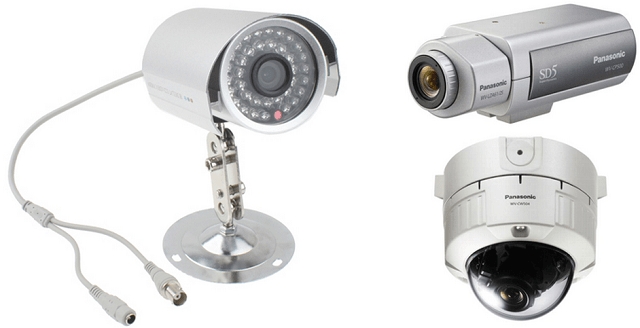Illumination of stairs by means of special lighting enhances the decorative expressiveness of interiors and increases the safety of using the staircase structure. Modern technologies make it possible to obtain original visual effects, thanks to which this structural element is perceived in a completely different way. Anyone can do this if they get acquainted with the principles of the formation of lighting design for staircases in a house or in a country house.
Methods for lighting stairs on steps with a motion sensor
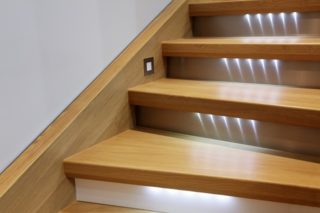
The lighting of the entire staircase or its individual sections can be controlled manually and automatically. In the first case, it is turned on using a conventional keyboard device, and the second is typical for household systems classified as "smart home". If desired, smart staircase lighting can be used not in the entire structure, but only on individual structural elements.
Automatic backlight
Automatic lighting control is a convenient option that simplifies the operation of lighting equipment. There are several known ways to implement this feature:
- by installing a sensitive sensor that responds to movement in the designated area;
- sound effect on the acoustic sensor (clap of palms, for example, or a command with a voice);
- light touch to the elements of the staircase.
In this case, modes with constant illumination or with variable intensity of the luminous flux are possible. It also provides the option of smoothly turning on and off the illuminators, or the same, but with a time delay.
The most widespread is LED staircase lighting, attracting the attention of users with its efficiency and compactness. According to the method of supplying power to the lighting elements, zonal lighting systems are divided into wired and wireless. The latter are used in a set with expensive additional equipment and can work over a radio channel or over a Wi-Fi network. To connect a conventional (wired) backlight, you will need to purchase a special cable.
The principle of operation of automatic staircase lighting
A typical staircase lighting on steps with a motion sensor may contain two sensitive elements (on the first and last steps of the structure). It is triggered by turning on when a person approaches the stairs and turning off when leaving it.
For flights of stairs with long flights, it is allowed to install more sensors. This possibility allows you to implement more complex schemes, one of which consists in alternately highlighting different stages. This creates the impression that the lighting moves after the person along the entire route.
Lighting equipment selection rules
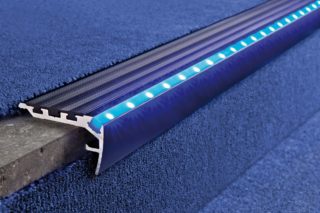
It is best to use LED devices as backlighting elements, combined in long strips or mounted separately. To the taste of the home owner, these can be single-color products, or multi-color RGB elements. The latter glow with shades of all colors initiated by the command of the controller built into the system.
LED illuminators are characterized by low power consumption, their service life is much longer than that of conventional daytime or halogen lamps. Other advantages of this type of lighting fixture include the fact that they operate from a reduced voltage of 12 (24) Volts. Thanks to this, the installation and operation of the LED-based backlight is absolutely safe and does not require special protective equipment (grounding, for example).
Preparing to install the backlight
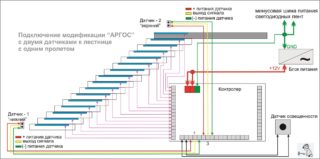
Before arranging the illumination of the steps of the stairs with a motion sensor, preparatory work is being carried out, consisting in drawing the diagram for connecting the lighting devices. A preliminary calculation will also be required to determine the length of the LED strip and the number of mounted motion sensors.
In the estimate for the development of a lighting system, controllers with drivers should be taken into account, which allow the possibility of updating the algorithm for turning on the LEDs. The controllers that are part of the well-known Arduino platform are very popular among specialists. Its distinctive feature is functional flexibility and the ability to choose ready-made software and hardware solutions.
Anyone who is not even familiar with programming elements can figure out the order of assembling such a kit. At the preparatory stage, you will need to select a power supply that is suitable in terms of power and a set of connecting wires to it. For the normal functioning of the system, it is enough to stock up on the simplest converter for an output voltage of 12 or 24 Volts. No additional electrical equipment is required for it.
DIY staircase lighting installation on steps
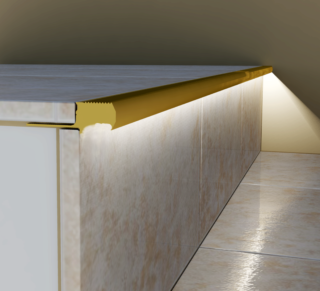
The installation procedure for the LED-based system staircase lighting is presented in the form of the following sequence of actions:
- The LED strip is cut into pieces of a pre-calculated size.
- A connector with wires already soldered to it is attached to the contact pads of each of them (observing the polarity).
- The surfaces of the steps on which the LED blanks are mounted are cleaned of dust (dirt) and degreased with acetone.
- The strips themselves are fixed by the self-adhesive layer on the reverse side, for which the protective film is removed from it.
- The power supply wiring is hidden in free niches, always present in the construction of stairs.
- They also prepare places for the installation of motion sensors and other electronic components included in the kit.
After the installation of the strip light sources is completed, the final stage of assembling the automatic system begins. First of all, the power supply lines to the converters are formed. If necessary, devices are installed in them to protect the working circuits from overloads and short circuits. For these purposes, standard current protection circuit breakers (AB) are used, designed for the appropriate setting.
Converters or power supplies, as well as controllers, are mounted in separate boxes in places where they can be easily accessed. The connecting wires are switched with the connectors intended for them, the power supply is connected to the household power supply.
At the final stage, the system is tested, during which the detected faults are identified and eliminated. If necessary, the backlight control program is adjusted.
Lighting characteristics
Lighting devices consist of a light source (lamps of one class or another) and special fittings that redistribute the light flux. In addition, they have specially designed mounts to protect the lamps from mechanical deformation, and there are voltage supply conductors.
According to the generally accepted classification, all devices suitable for lighting stairs are divided into three main classes:
- ordinary lamps;
- spotlights;
- LED strips.
The first two positions are products intended for zonal installation on stair treads and creating a concentrated luminous flux. In contrast, LED strips are mounted in the form of linear backlighting elements that provide a distributed illumination pattern.
The main characteristics of the used lamps and LED lamps:
- the nature of the distribution of light spots (curves of the intensity of the light KSS);
- flow distribution ratio;
- coefficient of performance or efficiency of luminescence.

In accordance with the distribution curves of KCC, all known lighting devices are divided into several types:
- concentrated in a specific area;
- deep (distant) lighting;
- cosine form;
- with a wide and narrow grip;
- with an even distribution of luminous fluxes.
By the type of power supply, lighting devices are divided into two classes: models connected to a 220 Volt network, and samples designed to work from voltage converters (12 or 24 Volts).

